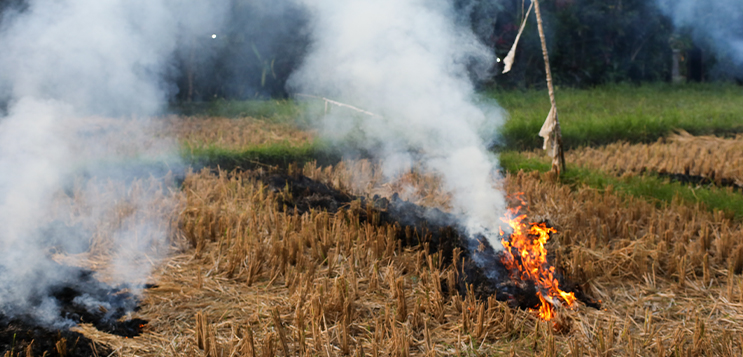
Every post-harvest season, farmers of Punjab and Haryana burn millions of tons of crop stubble. This practice creates clouds of smoke that blanket the Indo-Gangetic Plains. The consequences are far-reaching, impacting weather, air quality, and soil health, and prompting urgent calls for sustainable alternatives.
How Stubble Burning Affects Weather and Climate
Thick smoke from countless farm fires often forms a heavy smog layer that can disrupt local weather – during severe episodes, near-zero visibility and even lower daytime temperatures. The smoke also exacerbates thermal inversion – a phenomenon where warm air aloft traps cooler air near the surface – which keeps pollutants from dispersing. Additionally, open burning releases greenhouse gases like carbon dioxide and methane (plus black carbon soot) that contribute to global warming.
Contribution to Air Pollution in Northern India
Crop-residue fires are a major driver of air pollution in northern India. Studies estimate that farm fires account for up to 30% of the fine particulate (PM2.5) pollution in Delhi on peak burning days. Delhi’s air quality frequently hits “severe” levels as a result – for instance, the AQI reached 428 (hazardous) on November 15, 2024. Such pollution poses serious health risks to millions of residents.
Why Stubble Burning Isn’t Beneficial for Farmers
While burning provides a quick way to clear fields, it comes at a high cost to the farmers themselves. Soil fertility suffers: the intense heat kills beneficial microbes and burns away nutrients in the topsoil. Burning one tonne of straw can eliminate roughly 5.5 kg of nitrogen, 2.3 kg of phosphorus, 25 kg of potassium from the field, leaving the soil less fertile. This nutrient loss hurts yields and forces farmers to spend more on fertilizers, and authorities now impose steep fines (up to ₹30,000) for farm fires – making the practice economically unsound.
Government Efforts and Recent Initiatives (2023–2025)
Authorities have stepped up efforts in recent years to curb stubble burning, and it’s starting to pay off. Punjab saw about 70% fewer fires in 2024 compared to 2023. This success is credited to aggressive measures: a government program subsidized specialized farm equipment (over 17,000 Happy Seeders, Super Seeders, etc. provided), and air-quality authorities doubled the penalties for burning (up to ₹30,000) in 2024. Similar efforts in Haryana and neighboring states – along with awareness campaigns – have reinforced this improving trend.
Greener Alternatives to Stubble Burning
- Happy Seeder: A tractor-mounted planter that sows the next crop directly into the leftover stubble, eliminating the need to remove or burn residues.
- Bio-Decomposer Spray: A microbial solution sprayed on fields to rapidly decompose crop residue in-situ (an approach being used in Delhi and other regions to turn stubble into compost).
- Crop Diversification: Switching to shorter-duration rice varieties or alternative crops to reduce the amount of straw and give farmers a longer window to manage residues.
- Ex-Situ Use of Paddy Straw: Collecting and repurposing the straw as a resource – e.g. as fuel in biomass plants or as fodder and compost (youtube).
By embracing these solutions – alongside continued policy support – the region can move toward cleaner air and more sustainable farming practices without hurting farmers’ livelihoods.
